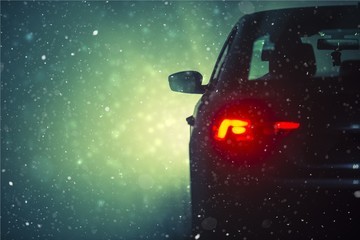WHEN BRIGHTS ARE NOT ENOUGH

Every Canadian winter, our essential workers drive to work in the dark and drive home in the dark. That dark commute is just a reality for hardworking Canadians. But it's a dangerous and challenging reality for these drivers and all who share our winter roads. And in these difficult times, it's more important than ever to avoid a car crash and give our hospital emergency rooms a break.
Overdriving your headlights happens when you drive too fast in the dark. When you drive too fast to stop in the illuminated pool of light right in front of your car, you create a blind crash zone. You literally drive right out of the safety of your own headlights. And too often, you drive right up the back of the driver, cyclist or pedestrian in front of you.
Winter driving demands a special set of driving skills. Those winter tires are never a free pass to drive dumb in the snow. Drive smart and be aware of the dark. You don't have to be speeding to overdrive your headlights.
What can winter drivers do to escape the worst of the winter dark?
Slow Down, Slow Down and Slow Down
Let your headlights do their job. Slow down to drive in safety on dark winter roads. It can be that simple.
See and Be Seen
Make sure your headlights and tail lights are working before you hit the road. Clean off winter salt and dirt on a regular basis. Understand automatic headlights only work if you set them on automatic. Many cars still require that you physically set the lights on automatic. And daytime running lights just do not give enough light for dark winter driving.
Drive For the Conditions
Respect winter. Dark driving conditions are nothing new for Canadian commuters. When you lose the light behind the wheel, use your common sense and lighten up on the gas pedal. Give yourself the time and distance you need to stop in safety.
Know Your Ride
Every driver needs to read their vehicle manual. Every driver should go back time and time again to check out everything from proper tire psi to the engine oil most recommended by the manufacturer. You would be shocked how many defendant drivers in injury claims don't know they have a manual in the glove box. Others don't know what a glove box is. Many manuals are available online if the previous owner forgot to pass it on. Car manufacturers print vehicle manuals for a reason. Your safety depends on knowing how your car works.
Watch For Signs
Reflective road signs trick us into thinking we can see farther than we can. We can see the sign in the distance. But we can't see the road right in front of us.
Can't See Nothin'
Just doesn't cut it. Mother Nature's driving snow is not to blame for a heavy foot on the pedal.
I've Got Winter Tires I'm Perfect Thank You
Winter tires have great safety benefits, but they aren't a magic bullet and won't save you from every driving trap.
Winter driving is not a walk in the park. We all know it. If you have to drive in dark winter conditions, be aware that overdriving your headlights is a real possibility when you don't match your speed to those dark conditions.
Want more info about the challenges of winter driving?
Read our Martin Law companion blog here.
If you have been injured in a car crash, or are a cyclist or pedestrian and have been hit by a vehicle, and you suspect the at fault driver was driving too fast for the dark road, let the investigating police officer know. If the police don't attend the scene, make sure to let the Collision Reporting Centre know. Then call an experienced injury lawyer.
Experienced injury lawyers know that a car crash is never just an accident.
Call Martin Law. Know Where You Stand.
Driving in the Dark
Slow Down to See the Light

